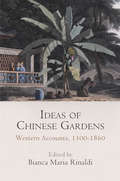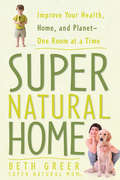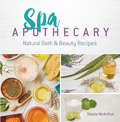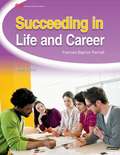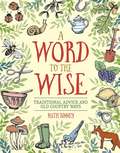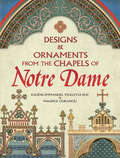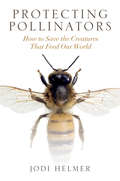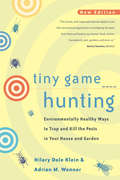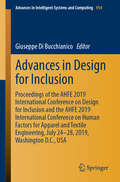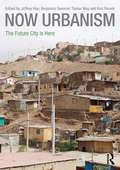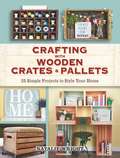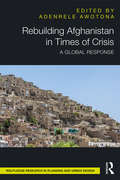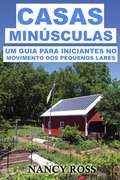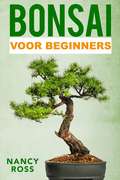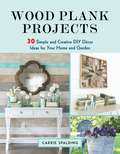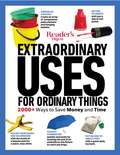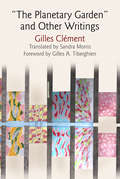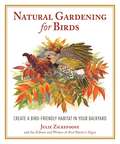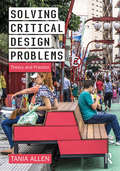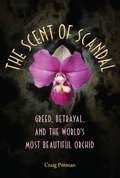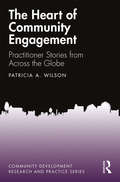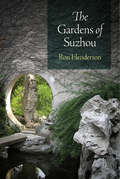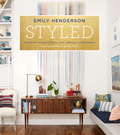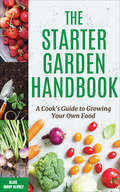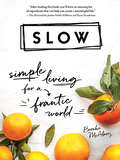- Table View
- List View
Ideas of Chinese Gardens: Western Accounts, 1300-1860 (Penn Studies in Landscape Architecture)
by Bianca Maria RinaldiEuropeans may be said to have first encountered the Chinese garden in Marco Polo's narrative of his travels through the Mongol Empire and his years at the court of Kublai Khan. His account of a man-made lake abundant with fish, a verdant green hill lush with trees, raised walkways, and a plethora of beasts and birds took root in the European imagination as the description of a kind of Eden. Beginning in the sixteenth century, permanent interaction between Europe and China took form, and Jesuit missionaries and travelers recorded in letters and memoirs their admiration of Chinese gardens for their seeming naturalness. In the eighteenth century, European taste for chinoiserie reached its height, and informed observers of the Far East discovered that sophisticated and codified design principles lay behind the apparent simplicity of the Chinese garden. The widespread appreciation of the eighteenth century gave way to rejection in the nineteenth, a result of tensions over practical concerns such as trade imbalances and symbolized by the destruction of the imperial park of Yuanming yuan by a joint Anglo-French military expedition.In Ideas of Chinese Gardens, Bianca Maria Rinaldi has gathered an unparalleled collection of westerners' accounts, many freshly translated and all expertly annotated, as well as images that would have accompanied the texts as they circulated in Europe. Representing a great diversity of materials and literary genres, Rinaldi's book includes more than thirty-five sources that span centuries, countries, languages, occupational biases, and political aims. By providing unmediated firsthand accounts of the testimony of these travelers and expatriates, Rinaldi illustrates how the Chinese garden was progressively lifted out of the realm of fantasy into something that could be compared with, and have an impact on, European traditions.
Super Natural Home: Improve Your Health, Home, and Planet--One Room at a Time
by Beth Greer“An invaluable book, filled with practical solutions on how to eat healthier, breathe cleaner air, and transform your home into a safe haven, free from toxic chemicals.”—Deepak Chopra From eliminating chemicals in your food and water to choosing clean beauty products, let the Super Natural Mom teach you everything you need to know to “live clean” in a toxic world! Beth Greer had been living what she considered a healthy lifestyle when a medical crisis prompted her to reevaluate everything—from the food she ate to the personal-care products she used and the environment she lived in. Now, in Super Natural Home, she shows the alarming extent of the dangerous chemicals we unwittingly expose ourselves to every day. As she did in her own life, she invites readers to put their lives under a microscope. The straightforward, solutions-based approach of Super Natural Home—complete with quizzes to help identify and correct potential toxic hot zones—speaks directly to what environment-conscious consumers really need: ultra-practical advice on what they can do right now to limit exposure to the poisons that are endangering them and their children. At a time when impeccable scientific research points to an alarming correlation between common chemical compounds and cancers, allergies, psychiatric disorders, and birth defects, among other serious health concerns, Super Natural Home gives consumers the tools to start protecting themselves and their families. Praise for Super Natural Home “Beth Greer’s clear, comprehensive, and practical book is a godsend for anyone living in America who wants to make a real impact on reducing the pollutions and poisons that are ubiquitous in our surroundings. She’s full of good humor, yet will help you live a far cleaner and more wholesome life than you might have thought possible. Hats off to her. Read this book.”—Peter Coyote, actor and author“Making simple changes can often have a profound impact not only on you and your family’s health but also on the planet. Beth Greer has done a fabulous job of creating a practical resource that will let you know what these changes are and how to easily implement them.”—Joseph Mercola, DO, founder of Mercola
Spa Apothecary: Natural Bath & Beauty Recipes
by Stasie McArthurYou can make luxurious products for skin, hair, and bath at home! All you need are basic cooking skills, a few simple kitchen tools, some common household ingredients — and this easy-to-follow guide. Spa Apothecary is a great resource for those who want to avoid the chemical additives of commercial products. Best of all, it will assist you in transitioning to a healthier, natural beauty routine and save you money, too!Author Stasie McArthur explains how to build your own personal apothecary. There is a supply list and more than 100 simple, preservative-free recipes, along with a helpful tip for each one. Included are moisturizers and toners for face and hand care, washes and scrubs for skin and body, shampoos and conditioners, and healing compounds for congestion and earaches. These handmade products make great gifts for family and friends — and can be customized with favorite scents and textures.
Succeeding in Life and Career: Foundations Of Human Studies
by Frances Baynor ParnellNIMAC-sourced textbook
A Word to the Wise: Traditional Advice and Old Country Ways
by Ruth BinneyIf you've ever wondered whether carrots improve your vision (they do) and why elephants have great memories, consult A Word to the Wise. You'll discover that it's never too late to learn from a proverb or an old wives' tale. This captivating book is a fascinating compilation of age-old expressions and customs, and its insights cover everything from health tips and kitchen tricks to gardening know-how and hints for predicting the weather.Folklorist Ruth Binney explains the truth behind such traditions as polishing windows with newspaper and blowing out birthday candles in a single breath. She also discusses whether classic adages are still relevant or, like eating oysters only in "R" months, their truths have faded with the passage of time. This charmingly illustrated volume of enduring wisdom makes a splendid keepsake as well as a fine gift.
Designs and Ornaments from the Chapels of Notre Dame (Dover Pictorial Archive Ser.)
by Eugene-Emmanuel Viollet-le-Duc Maurice OuradouArchitect and theorist Eugene-Emmanuel Viollet-le-Duc (1814–79), a prominent leader in the French Gothic Revival, was active in the restoration of medieval buildings. In 1845 he undertook one of the greatest projects in the history of restoration: the cleansing and restoration of the Cathedral of Notre-Dame in Paris. For the next twenty-three years he labored at his task, returning the cathedral to its original beauty and charm.This volume is based on a faithful reproduction of the restored mural paintings of the chapels, notable for their originality of design and the soft and subtle harmony of their coloring. The 60 full-page plates lend themselves to numerous graphic arts applications.
Protecting Pollinators: How to Save the Creatures that Feed Our World
by Jodi HelmerWe should thank a pollinator at every meal. These diminutive creatures fertilize a third of the crops we eat. Yet half of the 200,000 species of pollinators are threatened. Birds, bats, insects, and many other pollinators are disappearing, putting our entire food supply in jeopardy. In North America and Europe, bee populations have already plummeted by more than a third and the population of butterflies has declined 31 percent.Protecting Pollinators explores why the statistics have become so dire and how they can be reversed. Jodi Helmer breaks down the latest science on environmental threats and takes readers inside the most promising conservation initiatives. Efforts include famers reducing pesticides, cities creating butterfly highways, volunteers ripping up invasive plants, gardeners planting native flowers, and citizen scientists monitoring migration. Along with inspiring stories of revival and lessons from failed projects, readers will find practical tips to get involved. They will also be reminded of the magic of pollinators—not only the iconic monarch and dainty hummingbird, but the drab hawk moth and homely bats that are just as essential. Without pollinators, the world would be a duller, blander place. Helmer shows how we can make sure they are always fluttering, soaring, and buzzing around us.
Tiny Game Hunting: Environmentally Healthy Ways to Trap and Kill the Pests in Your House and Garden
by Courtlandt Johnson Hilary Dole Klein Adrian M. WennerEvery year Americans use a staggering five hundred million pounds of toxic pesticides in and around their homes, schools, parks, and roads--a growing health risk for people and the environment. But are these poisons really necessary? This book, appealing to the hunter in us all, shows how to triumph in combat with pests without losing the war to toxic chemicals. Tiny Game Hunting, written in a lively and entertaining style and illustrated with detailed drawings, gives more than two hundred tried-and-true ways to control or kill common household and garden pests without using toxic pesticides.
Advances in Design for Inclusion: Proceedings of the AHFE 2019 International Conference on Design for Inclusion and the AHFE 2019 International Conference on Human Factors for Apparel and Textile Engineering, July 24-28, 2019, Washington D.C., USA (Advances in Intelligent Systems and Computing #954)
by Giuseppe Di BucchianicoThis book addresses a range of topics in design, such as universal design; design for all; digital inclusion; universal usability; and accessibility of technologies regardless of users’ age, financial situation, education, geographic location, culture and language. It especially focuses on accessibility for people with auditory, cognitive, neurological, and visual impairments, ageing populations, and mobility for those with special physical needs. The book explores some of the overlaps between inclusive design and web accessibility to help managers, designers, developers, policy makers, and researchers optimize their efforts in these areas. Based on the AHFE 2019 International Conference on Design for Inclusion, held on July 24-28, held in Washington D.C., USA, it discusses new design technologies and highlights the disparate needs of the individuals within a community. Thanks to its multidisciplinary approach, it provides readers with various backgrounds with a timely, practice-oriented guide to design for inclusion.
Now Urbanism: The Future City is Here
by Jeffrey Hou Ken Yocom Benjamin Spencer Thaisa WayAfter more than a century of heroic urban visions, urban dwellers today live in suburban subdivisions, gated communities, edge cities, apartment towers, and slums. The contemporary cities we know are more often the embodiment of unexpected outcomes and unintended consequences rather than visionary planning. As an alternative approach for rethinking and remaking today’s cities and regions, this book explores the intersections of critical inquiry and immediate, substantive actions. The contributions inside recognize the rich complexities of the present city not as barriers or obstacles but as grounds for uncovering opportunity and unleashing potential. Now Urbanism asserts that the future city is already here. It views city making as grounded in the imperfect, messy, yet rich reality of the existing city and the everyday purposeful agency of its dwellers. Through a framework of situating, grounding, performing, distributing, instigating, and enduring, these contributions written by a multidisciplinary group of practitioners and scholars illustrate specificity, context, agency, and networks of actors and actions in the re-making of the contemporary city.
Crafting with Wooden Crates and Pallets: 25 Simple Projects to Style Your Home
by Natalie WrightYou don't have to be a carpenter or a home improvement expert to undertake these twenty-five projects, which combine elements of crafting and woodworking. Step-by-step instructions, accompanied by full-color photos, explain how to build surprisingly simple, attractive, and inexpensive indoor and outdoor furniture. The common denominators in these fun-filled and practical projects are ordinary wooden crates and pallets, which are readily available at craft and home improvement stores, vintage shops, and online. The first project demonstrates how easy it is to build your own crate from scratch. Indoor projects include storage shelves, nightstands, a bookshelf, an upholstered footstool, a benche, a side table, a desk, and storage units. Stepping outside, the projects feature a do-it-yourself children’s lemonade stand and a planter box. Several of the projects are equally functional indoors and out: decorative pieces, a game, a sign, a rolling cart, a toolbox, and other handy and playful items. The ease and simplicity of the projects make them a great way for novices — especially kids — to discover the pleasures and satisfaction of crafting and workworking.
Rebuilding Afghanistan in Times of Crisis: A Global Response
by Adenrele AwotonaRebuilding Afghanistan in Times of Crisis provides academics and researchers interested in planning, urbanism and conflict studies with a multidisciplinary, international assessment of the reconstruction and foreign aid efforts in Afghanistan. The book draws together expert contributions from countries across three continents – Asia, Europe and North America – which have provided external aid to Afghanistan. Using international, regional and local approaches, it highlights the importance of rebuilding sustainable communities in the midst of ongoing uncertainties. It explores the efficacy of external aid; challenges faced; the response of multilateral international agencies; the role of women in the reconstruction process; and community-based natural disaster risk management strategies. Finally, it looks at the lessons learned in the conflict reconstruction process to better prepare the country for future potential human, economic, infrastructural and institutional vulnerabilities.
Casas Minúsculas: Um guia para iniciantes no movimento dos pequenos lares
by Nancy RossDESCUBRA OS BÁSICOS PARA ENTRAR NO MOVIMENTO DAS CASAS MINÚSCULAS, GALINHAS DE QUINTAL, HOMESTEADING E MINI AGRICULTURA TUDO EM UM LIVRO! Aqui está uma prévia do que você vai aprender no primeiro livro ... Os benefícios de casas minúsculas Maneiras de financiar sua pequena casa Encontrando o local perfeito Hacks de fácil espaço para facilitar a vida em casa Idéias De Cozinha Sala de estar, Banheiro, Quartos Design Dicas e truques para entender a minúscula casa, vivendo Muito muito mais! Aqui está uma prévia do que você vai aprender no segundo livro ... Benefícios de galinhas do quintal O que você precisa para começar Obtendo a instalação para trazer as galinhas As melhores raças de quintal Compreender os comportamentos básicos do seu frango Problemas médicos com suas galinhas Ganhar dinheiro com suas galinhas Muito muito mais! Aqui está uma prévia do que você vai aprender no terceiro livro ... As noções básicas de Homesteading Criando seu próprio gado em seu quintal A magia da jardinagem para o seu próprio alimento Preservando sua comida para o inverno Fazendo suas próprias roupas Fazendo seus próprios itens domésticos Muito muito mais! Aqui está uma prévia do que você vai aprender no quarto livro ... Truques simples para maximizar seu espaço Melhores Plantas para Mini Agricultura Escolhendo o solo certo Controle de pragas Cuidar de ervas daninhas Gado que faz bem com Mini agricultura? Dicas para facilitar a criação de minicultura Muito muito mais!
Bonsai: voor beginners
by Nancy RossWILT U DE ESSENTIALS VAN BONSAI GROEIEN VOOR BEGINNERS? Hier is een voorbeeld van wat u zult leren ... Kies de juiste omgeving voor uw bonsai boom Uw bonsai de juiste voedingsstoffen geven De bonsai-boom snoeien De beste hulpmiddelen voor het verzorgen van uw bonsai boom De bonsai-boom verpotten Veel, veel meer!
Wood Plank Projects: 30 Simple and Creative DIY Décor Ideas for Your Home and Garden
by Carrie SpaldingPersonalize your indoor and outdoor spaces with beautiful, rustic, reclaimed wood pieces. Want to make a statement in your home? Look no further than the humble yet versatile wood plank! Reclaim, recycle, and repurpose wood planks to create unique, stylish home décor pieces that are guaranteed to bring warmth and beauty into your living spaces—all on a budget! Featuring thirty DIY tutorials for both indoors and outdoors, Wood Plank Projects includes simple beginner projects that will be ready in an hour, as well as larger and more impressive pieces—with step-by-step instructions and beautiful photographs. Find projects for every room in the house, from rustic photo frames and farmhouse clocks to outdoor benches and reclaimed tabletops. Learn to make: Colorful Vintage SignWeathered Wood Plank WallScrap Wood Sunburst MirrorCurvy Wooden HeadboardWood Plank Garden Planter BoxModern Farmhouse Barn DoorAnd more! You’ll also find tips for choosing the right wood, finding inexpensive reclaimed materials, and using paint and stain to give new wood a weathered look or a perfect finish. Be inspired and create your own beautiful, handmade wood plank décor!
Reader's Digest Extraordinary Uses for Ordinary Things New Edition
by Reader'S DigestAn updated edition, now fully illustrated and in color, of the classic guide to using common household items to replace, restore, repair, or revive almost anything in your household—including yourself.When you have a household problem, don’t run to the store and waste good money, just open your pantry door—and EXTRAORDINARY USES FOR ORDINARY THINGS. You’ll be amazed at what you can do with baby oil, bleach, duct tape, tea, rubbing alcohol, and dozens of other handy items. This book will open your eyes to more than 2,000 creative and helpful uses you can make of familiar household products, such as: • Aspirin can revive a dead car battery and a coating of petroleum jelly will keep the battery’s terminals from corroding • A dab of shaving cream can keep your bathroom mirror from fogging and can remove juice stains on carpeting • Petroleum jelly makes a great lip balm, makeup remover, and moisturizer • A turkey baster is the perfect tool for watering Christmas trees and hard-to-reach plants • Beer can be combed through your hair as a setting lotion, used as lure to trap insects, and polish gold jewelry • Sandpaper can be used to sharpen needles and scissors, roughen slippery soles of new shoes, remove ink stains and scuff marks from suede, and remove stains on grout lines • Wax paper will prevent a cast-iron skillet from rusting, restore the nonstick surface on your iron, and use on the bottom of a microwave when cooking messy foods. If you hate to throw things away or if you delight in dreaming up new ways to use ordinary items, then you’ll love the ideas in this book. You’ll be amazed at the problems you can solve. It’s a book you’ll be sure to turn to again and again for helpful ideas, trustworthy advice, and entertaining reading.
"The Planetary Garden" and Other Writings (Penn Studies in Landscape Architecture)
by Gilles ClémentCelebrated landscape architect Gilles Clément may be best known for his public parks in Paris, including the Parc André Citroën and the garden of the Musée du Quai Branly, but he describes himself as a gardener. To care for and cultivate a plot of land, a capable gardener must observe in order to act and work with, rather than against, the natural ecosystem of the garden. In this sense, he suggests, we should think of the entire planet as a garden, and ourselves as its keepers, responsible for the care of its complexity and diversity of life."The Planetary Garden" is an environmental manifesto that outlines Clément's interpretation of the laws that govern the natural world and the principles that should guide our stewardship of the global garden of Earth. These are among the tenets of a humanist ecology, which posits that the natural world and humankind cannot be understood as separate from one another. This philosophy forms a thread that is woven through the accompanying essays of this volume: "Life, Constantly Inventive: Reflections of a Humanist Ecologist" and "The Wisdom of the Gardener." Brought together and translated into English for the first time, these three texts make a powerful statement about the nature of the world and humanity's place within it.
Natural Gardening for Birds: Create a Bird-Friendly Habitat in Your Backyard (Rodale Organic Gardening Book Ser.)
by Julie ZickefooseA Practical Illustrated Bird-Oriented Gardening Book with Great Reference ChartsBird-watchers everywhere dream of a landscape dotted with fruiting shrubs, nests tucked into twining vines, and birds flocking to feeding stations. Let Natural Gardening for Birds show you how to lay out the welcome mat for birds by considering all of their needs, including year-round food, water, and shelter. Whether you’re looking to create a hummingbird garden, install a water feature, create alluring perches, or simply designate a corner of your property as a natural area, you’ll find all the inspiration and information you need in Natural Gardening for Birds, including:The best plants for nectar, fruit, and seedsThe most attractive foods to offer birdsHousing for cavity-nesting birdsSimple habitat enhancements like snags and perchesRegion-specific planting ideas and charts
Solving Critical Design Problems: Theory and Practice
by Tania AllenSolving Critical Design Problems demonstrates both how design is increasingly used to solve large, complex, modern-day problems and, as a result, how the role of the designer continues to develop in response. With 13 case studies from various fields, including program and product design, Tania Allen shows how types of design thinking, such as systems thinking, metaphorical thinking, and empathy, can be used together with methods, such as brainstorming, design fiction, and prototyping. This book helps you find ways out of your design problems by giving you other ways to look at your ideas, so that your designs make sense in their setting. Solving Critical Design Problems encourages a design approach that challenges assumptions and allows designers to take on a more critical and creative role. With over 100 images, this book will appeal to students in design studios, industrial and product design, as well as landscape and urban design.
The Scent of Scandal: Greed, Betrayal, and the World's Most Beautiful Orchid (Florida History and Culture)
by Craig PittmanAfter its Peruvian discovery in 2002, Phragmipedium kovachii became the rarest and most sought-after orchid in the world. Prices soared to $10,000 on the black market. Then one showed up at Marie Selby Botanical Gardens, where every year more than 100,000 people visit. They come for the lush landscape on Sarasota Bay and for Selby's vast orchid collection, one of the most magnificent in the world. <P><P>The collision between Selby's scientists and the smugglers of Phrag. Kovachii, a rare ladyslipper orchid hailed as the most significant and beautiful new species discovered in a century, led to search warrants, a grand jury investigation, and criminal charges. It made headlines around the country, cost the gardens hundreds of thousands of dollars in donations, and led to tremendous internal turmoil. <P><P>Investigative journalist Craig Pittman unravels this tangled web to shine a spotlight on flaws in the international treaties governing trade in endangered wildlife--which may protect individual plants and animals in shipping but do little to halt the destruction of whole colonies in the wild. <P><P>The Scent of Scandal unspools like a riveting mystery novel, stranger than anything in Susan Orlean's The Orchid Thief or the film Adaptation. Pittman shows how some people can become so obsessed--with beauty, with profit, with fame--that they will ignore everything, even the law.
The Heart of Community Engagement: Practitioner Stories from Across the Globe (Community Development Research and Practice Series)
by Patricia A. WilsonDrawing on first-hand accounts of action research in the Americas, Africa, and Asia, The Heart of Community Engagement illustrates the transformative learning journeys of exemplary catalysts for community-based change. Practitioners’ stories of community engagement for social justice in the Global South elucidate the moments of insight and transformation that deepened their practice: how to deal with uncertainty, recognize their own blind spots, become aware of what is emergent and possible in the moment, and weave an inclusive bond of love, respect, and purpose. Each successive narrative adds a deeper level of understanding of the inner practice of community engagement. The stories illuminate the reflective, or inner, practice of the outside change agent, whether a planner, designer, participatory action researcher, or community development practitioner. From a shantytown in South Africa, to a rural community in India, or an informal settlement in peri-urban Mexico, the stories focus attention on the greatest leverage point for change that we, as engaged practitioners, have: our own self-awareness. By the end of the book, the practitioners are not only aware of their own conditioned beliefs and assumptions, but have opened their minds and hearts to the complex and dynamic patterns of emergent change that is possible. This book serves as a much-needed reader of practice stories to help instructors and students find the words, concepts, and examples to talk about their own subjective experience of community engagement practice. The book applies some of the leading-edge concepts from organizational development and leadership studies to the fields of planning, design, and community engagement practice. Key concepts include the deep dive of sensing the social field, seeing the whole, and presencing the emergent future. The book also provides a creative bridge between participatory action research and design thinking: user-based design, rapid prototyping, and learning from doing.
The Gardens of Suzhou (Penn Studies in Landscape Architecture)
by Ron HendersonSuzhou, near Shanghai, is among the great garden cities of the world. The city's masterpieces of classical Chinese garden design, built from the eleventh through the nineteenth centuries, attract thousands of visitors each year and continue to influence international design. In The Gardens of Suzhou, landscape architect and scholar Ron Henderson guides visitors through seventeen of these gardens. The book explores UNESCO world cultural heritage sites such as the Master of the Nets Garden, Humble Administrator's Garden, Lingering Garden, and Garden of the Peaceful Mind, as well as other lesser-known but equally significant gardens in the Suzhou region.Unlike the acclaimed religious and imperial gardens found elsewhere in Asia, Suzhou's gardens were designed by scholars and intellectuals to be domestic spaces that drew upon China's rich visual and literary tradition, embedding cultural references within the landscapes. The elements of the gardens confront the visitor: rocks, trees, and walls are pushed into the foreground to compress and compact space, as if great hands had gathered a mountainous territory of rocky cliffs, forests, and streams, then squeezed it tightly until the entire region would fit into a small city garden.Henderson's commentary opens Suzhou's gardens, with their literary and musical references, to non-Chinese visitors. Drawing on years of intimate experience and study, he combines the history and spatial organization of each garden with personal insights into their rockeries, architecture, plants, and waters. Fully illustrated with newly drawn plans, maps, and original photographs, The Gardens of Suzhou invites visitors, researchers, and designers to pause and observe astonishing works from one of the world's greatest garden design traditions.
Styled: Secrets for Arranging Rooms, from Tabletops to Bookshelves
by Emily Henderson Angelin BorsicsThe ultimate guide to thinking like a stylist, with 1,000 design ideas for creating the most beautiful, personal, and livable roomsIt's easy to find your own style confidence once you know this secret: While decorating can take months and tons of money, styling often takes just minutes. Even a few little tweaks can transform the way your room feels. At the heart of Styled are Emily Henderson's ten easy steps to styling any space. From editing out what you don't love to repurposing what you can't live without to arranging the most eye-catching vignettes on any surface, you'll learn how to make your own style magic. With Emily's insider tips and more than 1,000 unique ideas from 75 envy-inducing rooms, you'll soon be styling like you were born to do it.
The Starter Garden Handbook: A Cook's Guide to Growing Your Own Food
by Alice Mary AlvrezThe author of The Going Green Handbook gives you tips for growing vegetables, reducing your food budget, eating organic, and being eco-friendly. Here in one pretty package is everything you need to know to have your garden and eat it, too! Inside, you’ll find tips for greening up all areas of your garden. Learn surprising facts about your impact on the environment and change your habits with do-it-yourself ideas in The Starter Garden Handbook. Organic gardener, environmentalist, and pop-up chef Alice Mary Alvrez will help you start with small changes, like growing basic herbs, and work your way up to raising bees. Learn how to raise many kinds of vegetables and fruits, and get tips on composting weeds, clippings, and leftovers so you have nutrient-rich soil. Whether you are at the green rookie level, eco-master, or full-on gardening guru, you can learn to grow your own food and help the planet every week of the year with The Starter Garden Handbook. If you’re a fan of The Vegetable Gardener’s Bible, you’ll love The Starter Garden Handbook! “Nowadays people think they have to quit their day job and toil in the hot sun all day. Not true! Most gardening is in the planning and once you have established your plot, I promise you, it will become your Happy Place. Nothing feels better than serving a delicious dish from plants you grew from seeds.” —Susannah Seton, author of Simple Pleasures of the Garden
Slow: Simple Living for a Frantic World
by Brooke McAlaryFree yourself from the frantic and embrace the joy of slow..."After reading this book, you'll have an amazing list of ingredients that can help you create a meaningful life, too!" —The Minimalists Joshua Fields Millburn and Ryan Nicodemus"Finally, a slow living guide for the imperfect folks . . . Brooke McAlary's exuberant, honest words are a refreshing contribution to the slow living community. If you're seeking a simpler path, start here." —Erin Loechner, Blogger at DesignforMankind.com and author of Chasing SlowAre you constantly striving to keep up with life's busy expectations? It's easy to feel consumed with the desire to "succeed" and "acquire", and miss the simple opportunities waiting for you to slow down: a walk in the forest, sharing laughter with family, a personal moment of gratitude...Once upon a time, it became clear to Brooke McAlary that the key to happiness was discovering a simpler, more fulfilling existence. She put the brakes on her stressful path, and reorganized her life to live outside the status-quo, emphasizing depth, connection and meaningful experiences. Alongside Brooke's affirming personal stories of breaking down and rising up, Slow provides practical advice and fascinating insights into the benefits and challenges of the slow life, such as: —Decluttering to de-owning—Messiness to mindfulness—Asking why, to asking where to now?Slow is an inspirational guide on creating a life filled with the things that really matter, and is meant for anyone seeking peace, meaning, and joy in their otherwise rapid lives. Slowly—of course.
